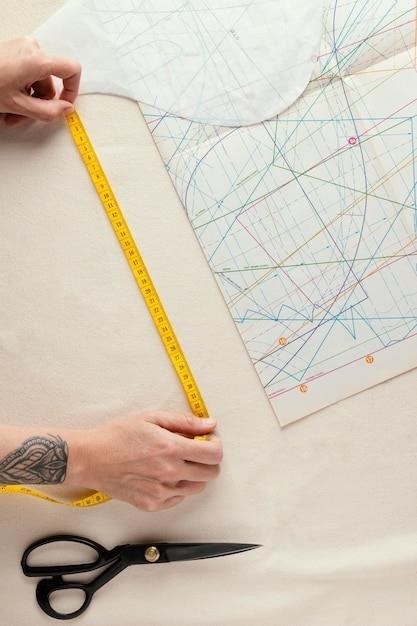Tailor Body Measurement Chart for Sewing PDF⁚ A Comprehensive Guide
This guide provides a comprehensive overview of tailor body measurement charts, their importance, how to take accurate measurements, and the benefits of using them for sewing and tailoring projects.
Introduction
Tailor body measurement charts are essential tools for anyone involved in sewing or tailoring. These charts provide a standardized system for recording precise body measurements, which are crucial for creating garments that fit perfectly. Whether you’re a professional tailor, an avid seamstress, or simply want to ensure a perfect fit for your own clothing, understanding and utilizing tailor body measurement charts is a valuable skill.
Types of Tailor Measurement Charts
Tailor measurement charts are designed for different target audiences, with specific measurements tailored to each group. Male measurement charts focus on features like chest, waist, and shoulder, while female charts include bust, waist, and hips. Children’s measurement charts are scaled down to accommodate smaller body sizes and growth patterns, ensuring accurate fit for young individuals.
Male Measurement Charts
Male measurement charts typically include measurements for chest, waist, hips, shoulder, neck, sleeve length, jacket length, inseam, full crotch, and back chest. These charts are essential for tailoring men’s clothing, ensuring a perfect fit for shirts, suits, trousers, and other garments. The information on these charts helps tailors create patterns and adjust garments for a custom fit.
Female Measurement Charts
Female measurement charts typically include measurements for bust, waist, hips, shoulder, neck, sleeve length, jacket length, inseam, full crotch, and back chest. These charts are essential for tailoring women’s clothing, ensuring a perfect fit for dresses, blouses, skirts, pants, and other garments. The information on these charts helps tailors create patterns and adjust garments for a custom fit.
Children’s Measurement Charts
Children’s measurement charts are specifically designed for tailoring clothes for kids. They include measurements like chest, waist, hips, shoulder, neck, sleeve length, and inseam. These charts often have age-specific ranges and provide accurate sizing for children’s clothing, ensuring a comfortable and stylish fit for growing kids.
Importance of Accurate Measurements
Accurate body measurements are crucial for creating well-fitting garments. They ensure that clothes are neither too tight nor too loose, providing comfort and a flattering silhouette. Precise measurements prevent alterations and ensure a garment that complements the wearer’s body shape and size, enhancing overall satisfaction with the final creation.
Taking Body Measurements
Taking accurate body measurements is essential for creating well-fitting garments. Use a flexible tape measure and ensure it is held flat against the body, snug but not too tight. Stand straight and relax your body for the most accurate results. Take measurements in inches or centimeters, depending on your preference, and record them carefully on a tailor measurement chart.
Bust/Chest
Measure the circumference of your chest at the fullest part of your bust, wrapping the tape measure under your armpits, around your shoulder blades, and back to the front. Ensure the tape measure is level and parallel to the floor. This measurement is crucial for ensuring a proper fit for tops, dresses, and jackets.
Waist
Measure around your natural waistline, which is the narrowest part of your torso, typically above your belly button. Relax your body and maintain a natural stance. Keep the tape measure parallel to the floor and snug but not tight. This measurement is essential for fitting pants, skirts, and dresses.
Hips
Stand with your feet together and measure around the fullest part of your hips, ensuring the tape measure is parallel to the floor. This measurement is crucial for fitting pants, skirts, and dresses, as it determines the garment’s fit around your lower body.
Shoulder
Measure the distance across your back, from one shoulder bone to the other, keeping the tape measure parallel to the floor. This measurement is essential for fitting tops, jackets, and dresses, as it determines the garment’s width across your shoulders.
Neck
Wrap the tape measure around your neck, just below the Adam’s apple, keeping it snug but not too tight. This measurement is crucial for determining the fit of collars, shirts, and dresses, ensuring a comfortable and flattering fit around your neck.
Sleeve Length
With your arm slightly bent at the elbow, measure from the top of your shoulder, where it meets your neck, down to your wrist bone. This measurement is essential for creating sleeves that are the perfect length, ensuring both comfort and style in your garments.
Jacket Length
To measure jacket length, start at the base of your neck, where your shoulder and neck meet, and run the tape measure straight down your spine. Stop at the desired finished length for your jacket, which is typically just above the top of your fingertips or the bottom of your hips. This measurement ensures the jacket fits perfectly without being too short or too long.
Inseam
The inseam measurement is essential for pants and trousers. Stand with your feet together and measure the inside of your leg from the crotch seam to the bottom of your ankle. Ensure the tape measure runs straight down the inside of your leg for an accurate measurement. This measurement helps ensure the pants sit comfortably at your waist and have the correct length.
Full Crotch
The full crotch measurement is crucial for ensuring a comfortable fit in pants and trousers. It’s measured from the waistline, down the front of the leg, through the crotch, and up the back of the leg to the waistline. This measurement is essential for determining the correct rise and length of the garment, ensuring proper fit and comfort.
Back Chest
The back chest measurement is vital for creating well-fitting garments, particularly jackets and coats. It is taken horizontally across the back, just below the shoulder blades, ensuring the garment fits snugly without feeling restrictive. This measurement is crucial for achieving a proper fit and ensuring comfort in the upper body.
Using a Tailor Measurement Chart
Once you have taken all the necessary body measurements, it’s time to utilize your tailor measurement chart effectively. Record each measurement accurately in the designated spaces on the chart, ensuring clarity and consistency. These charts are often customizable, allowing you to adjust the measurements based on your specific needs and desired fit. Printable templates are readily available online, offering a convenient way to keep track of all the essential body measurements for your sewing projects.
Recording Measurements
When recording measurements on a tailor measurement chart, it is essential to maintain accuracy and clarity. Use a clear and legible handwriting to ensure that the measurements are easily readable later. It is helpful to note any specific details regarding the person being measured, such as their posture, body type, or any unusual features that might affect the fit of their garments; This detailed information can help you create a more precise and tailored fit for your sewing projects.
Customizing Charts
Tailor measurement charts can be customized to meet specific needs. You can add additional measurements for particular garments, such as the length of a sleeve or the circumference of a neck. You can also modify the format of the chart to suit your preferences, including the font size, layout, and even the addition of sections for notes or special instructions. This customization allows you to create a tailor measurement chart that perfectly aligns with your sewing workflow and projects.
Printable Templates
Numerous online resources offer free printable tailor measurement chart templates. These templates provide a standardized format for recording body measurements, making it easier to track and compare data. They often include clear instructions and diagrams for taking measurements accurately, ensuring consistency across multiple projects. Printable templates are a convenient and readily accessible resource for anyone involved in sewing or tailoring.
Benefits of Using a Tailor Measurement Chart
Tailor measurement charts offer several benefits for individuals and professionals involved in sewing and tailoring. They ensure a perfect fit by providing accurate and consistent measurements for each garment. The charts streamline the process, improving efficiency by eliminating the need for repeated measurements and adjustments. Furthermore, they allow for the tracking of body composition changes over time, enabling tailored garments to adapt to evolving body shapes.
Ensuring a Perfect Fit
A tailor measurement chart is essential for achieving a perfect fit in garments. By accurately capturing individual body dimensions, it eliminates guesswork and ensures that clothing is tailored to the wearer’s specific shape and size; This precision results in garments that are comfortable, flattering, and well-proportioned, enhancing the overall aesthetic and wearability of the final product.
Improving Efficiency
Tailor measurement charts streamline the sewing process by providing a structured and organized approach to recording measurements. This eliminates the need for repeated measurements and ensures accuracy, reducing the risk of errors and rework. By using a standardized chart, tailors can quickly and efficiently capture all necessary data, saving time and effort throughout the project.
Tracking Body Composition Changes
Tailor measurement charts can serve as valuable tools for tracking changes in body composition over time. By recording measurements regularly, individuals can monitor their progress in areas such as weight loss, muscle gain, or alterations in body shape. This information can be used to adjust clothing sizes, tailor new garments, and make informed decisions regarding fitness and health goals.
Resources for Tailor Measurement Charts
Numerous resources are available to assist individuals in finding and utilizing tailor measurement charts. Online platforms offer printable templates, while tailoring services often provide their own customized charts. Searching for “tailor measurement chart PDF” or “printable body measurement chart” can yield a wealth of options, allowing individuals to choose the most suitable resource for their needs.
Online Resources
The internet offers a plethora of online resources for tailor measurement charts. Numerous websites provide downloadable printable templates, allowing users to create their own charts. These online resources often include detailed instructions on how to take accurate measurements, ensuring a perfect fit for any garment.
Printable Templates
Printable tailor measurement chart templates offer a convenient and readily available solution for recording body measurements. These templates, often downloadable as PDF files, provide a structured format for documenting key measurements, ensuring accuracy and consistency.
Tailoring Services

Professional tailoring services often utilize tailor measurement charts to ensure precise garment fitting. Tailors rely on these charts to capture accurate body measurements, enabling them to create custom-made garments that flatter and fit perfectly.
Tailor body measurement charts are essential tools for achieving perfect garment fits. By accurately capturing body dimensions, these charts empower both individuals and professionals to create tailored garments with precision and ease. Whether for personal sewing projects or professional tailoring services, using a tailor measurement chart ensures a successful and satisfying outcome.
